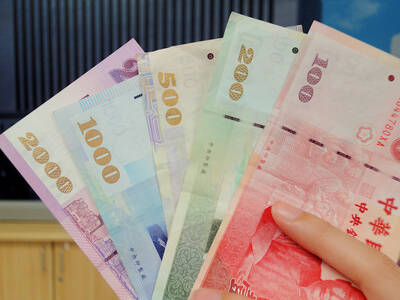Financial markets remained on edge on Friday after the Bush administration’s proposal for a US$700 billion banking bailout ran into opposition from Republican lawmakers. Stocks ended mixed, with big financial companies lifting the Dow Jones industrials more than 120 points, but worries about smaller banks and parts of the technology sector taking much of the market lower.
Demand for safe-haven buying in government debt remained high as investors uneasily watched events in Washington, where the Bush administration tried to overcome Republican objections to its rescue package.
Republican lawmakers are concerned about the cost of the proposal, and they balked at the plan after congressional leaders said on Thursday they had reached an agreement in principle. Shortly after Friday’s opening bell on Wall Street, US President George W. Bush said at the White House lawmakers can express doubts but ultimately should “rise to the occasion” and approve a plan to stave off what he sees as an economic calamity.
The Dow rose 121.07, or 1.10 percent, to 11,143.13. Gains by JPMorgan Chase & Co and Bank of America Corp gave support to the 30-stock index. Most of their advance came late in the session as investors placed bets that a deal would emerge from Washington over the weekend.
Broader indicators were mixed. The Standard & Poor’s 500 index rose 3.83, or 0.32 percent, to 1,213.01, and the NASDAQ composite index fell 3.23, or 0.15 percent, to 2,183.34.
Declining issues outnumbered advancers by more than 2 to 1 on the New York Stock Exchange, where volume came to 1.17 billion shares.
The banking rescue is designed to remove billions of dollars of bad mortgages and other now-toxic assets from the books of financial firms in a bid to free up lending. Tight lending conditions make it harder and more expensive for businesses and consumers to borrow money, a headwind for the economy.
In a last-minute shake up, some Republican lawmakers wanted an alternative plan under which the government would provide insurance to companies that agree to hold frozen assets, rather than have the US purchase the assets.
Volume was relatively light on Friday as many investors chose to just wait. That helped skew some of the movements in the major indexes.
“I think the markets are on pause trying to figure out where this is going to go. Congress is still there,” said Mark Coffelt, portfolio manager at Empiric Funds in Austin, Texas. “Right now everyone is a little bit shell-shocked.”
With no deal in place as trading ended Friday, investors were certainly going to be uneasy throughout the weekend. And there was no way to predict whether tomorrow morning would bring calmer markets after weeks of intense volatility, or whether the turbulence would accelerate. Even if a deal is reached over the weekend, its terms will determine how the markets start the week.
Credit markets remained strained on Friday, though they showed improvement. The yield on the three-month Treasury bill, considered the safest short-term investment, rose to 0.84 percent from 0.72 percent late Thursday. The lower the yield on a T-bill, the more desperation there is in the market; investors are at times willing to take the slimmest returns to preserve their principal. The yield on the benchmark 10-year Treasury note, which moves opposite its price, rose to 3.85 percent from 3.84 percent late on Thursday.
For the week, which again saw triple-digit moves in the Dow, the blue chip average lost 2.15 percent and the NASDAQ declined 3.98 percent.
Stocks traded unevenly on Friday, with technology shares falling sharply after Research In Motion Ltd warned late on Thursday that its gross margins would contract in the current quarter because of the costs for producing three new BlackBerry models. The stock fell US$25.45, or 26 percent, to US$72.08.
The market was also uneasy after Washington Mutual Inc became the largest US bank to fail. The Federal Deposit Insurance Corp seized WaMu on Thursday and then sold the thrift’s banking assets to JPMorgan for US$1.9 billion. It was the latest financial firm to collapse under the weight of enormous bad bets on the mortgage market.
Although WaMu’s failure was expected, it nonetheless underscored for investors how widespread the problems are in the financial sector.
Coffelt said the market appeared to take some comfort, however, from the orderly fall of WaMu. Several analysts praised the move as a wise takeover for JPMorgan.
JPMorgan rose US$4.78, or 11 percent, to US$48.24 and was the biggest decliner among the Dow industrials. WaMu fell US$1.53, or 90.3 percent, to US$0.16.
Meanwhile, Bank of America, which last week snapped up Merrill Lynch, rose US$2.33, or 6.8 percent, to US$36.70.
Bank of America and JP Morgan are now the first and second largest banks US banks, respectively, perhaps offering investors some reassurance about the safety provided by their large asset bases in a market short on liquidity.
But worries about some other banks, including regionals, persisted after the failure of WaMu. Wachovia Corp fell US$3.70, or 27 percent, to US$10, while National City Corp fell US$1.28, or 26 percent, to US$3.71.
Concerns about the broader US economy persist. The US Department of Commerce said the spring’s economic rebound was less robust than previously estimated. GDP increased at a 2.8 percent annual rate in the second quarter. That fell short of the 3.3 percent growth estimated a month ago, but was still better than two previous dismal quarters.

People can preregister to receive their NT$10,000 (US$325) cash distributed from the central government on Nov. 5 after President William Lai (賴清德) yesterday signed the Special Budget for Strengthening Economic, Social and National Security Resilience, the Executive Yuan told a news conference last night. The special budget, passed by the Legislative Yuan on Friday last week with a cash handout budget of NT$236 billion, was officially submitted to the Executive Yuan and the Presidential Office yesterday afternoon. People can register through the official Web site at https://10000.gov.tw to have the funds deposited into their bank accounts, withdraw the funds at automated teller

PEACE AND STABILITY: Maintaining the cross-strait ‘status quo’ has long been the government’s position, the Ministry of Foreign Affairs said Taiwan is committed to maintaining the cross-strait “status quo” and seeks no escalation of tensions, the Ministry of Foreign Affairs (MOFA) said yesterday, rebutting a Time magazine opinion piece that described President William Lai (賴清德) as a “reckless leader.” The article, titled “The US Must Beware of Taiwan’s Reckless Leader,” was written by Lyle Goldstein, director of the Asia Program at the Washington-based Defense Priorities think tank. Goldstein wrote that Taiwan is “the world’s most dangerous flashpoint” amid ongoing conflicts in the Middle East and Russia’s invasion of Ukraine. He said that the situation in the Taiwan Strait has become less stable

CONCESSION: A Shin Kong official said that the firm was ‘willing to contribute’ to the nation, as the move would enable Nvidia Crop to build its headquarters in Taiwan Shin Kong Life Insurance Co (新光人壽) yesterday said it would relinquish land-use rights, or known as surface rights, for two plots in Taipei’s Beitou District (北投), paving the way for Nvidia Corp to expand its office footprint in Taiwan. The insurer said it made the decision “in the interest of the nation’s greater good” and would not seek compensation from taxpayers for potential future losses, calling the move a gesture to resolve a months-long impasse among the insurer, the Taipei City Government and the US chip giant. “The decision was made on the condition that the Taipei City Government reimburses the related

FRESH LOOK: A committee would gather expert and public input on the themes and visual motifs that would appear on the notes, the central bank governor said The central bank has launched a comprehensive redesign of New Taiwan dollar banknotes to enhance anti-counterfeiting measures, improve accessibility and align the bills with global sustainability standards, Governor Yang Chin-long (楊金龍) told a meeting of the legislature’s Finance Committee yesterday. The overhaul would affect all five denominations — NT$100, NT$200, NT$500, NT$1,000 and NT$2,000 notes — but not coins, Yang said. It would be the first major update to the banknotes in 24 years, as the current series, introduced in 2001, has remained in circulation amid rapid advances in printing technology and security standards. “Updating the notes is essential to safeguard the integrity